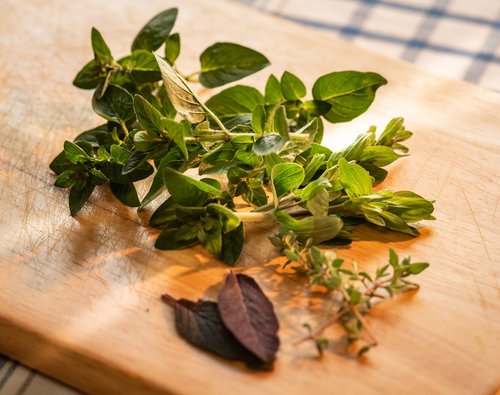
Are you curious about nature, and do you like unusual plants as much as seasoning your food and discovering new flavors?
Herbs and aromatic plants are essential for enhancing the garden just as they are in cooking dishes. It is always useful for gardeners to have spices on hand, in pots on the window sill or nearby in the garden!
In addition to traditional basil, parsley or chives , did you know that there are amazing herbs to taste particular one does not easily found on the market? Mushroom plant, Shiso or Mojito Mint … here are 7 varieties of unclassifiable and delicious aromatic herbs, to try absolutely! Reserve a special place for them with your classic aromatics in the garden, vegetable patch or in pots to enjoy around your patio as you relax on a comfy patio sofa!
1. Lemon Balm taste of orange
Lemon Balm is an aromatic perennial whose leaves usually exhale a delicious lemon scent when crumpled. The Melissa orange flavor , Lemon Balm or orange scent differs from the usual species by its thicker leaves, flowers bright lavender larger and the smell of foliage that gives off orange fragrances and surprising tangerine.
In the kitchen, the fresh or dry leaves of this original lemon balm bring a tangy note to your infusions, herbal teas, salads, desserts and even liqueurs.
In infusion before bedtime, lemon balm just like other lemon balms, has sedative properties that promote relaxation and sleep. It also has digestive properties.
The leaves are harvested from April to October, as needed. They freeze and accept drying well upside down in an airy room.
2. Mojito Mint
Here is a variety of mint like no other! This amazing Mint hemingwayensis (Mentha nemorosa), or Mojito-flavored mint , also known by the names, “Cuban mint” or even “Hemingway mint”, is really different from many other varieties of mint, such as the spearmint or peppermint .
Its foliage reveals a powerful menthol aroma, slightly lemony and peppery, very refreshing. The leaves of this amazing mint go perfectly with lime, ideal for preparing cocktails and especially the famous Cuban cocktail which it is named after. They also lend themselves to the realization of many exotic recipes, in particular Asian dishes. They flavor raw vegetables, summer grills, yogurt-based sauces or fruit salads, tabbouleh. They make it possible to flavor lemonade, tea, infusions.
The leaves are harvested as and when you need them and are best eaten freshly cut. To prepare the Mojito, keep them whole and crumple them beforehand in the palm of your hand to release their aromas before plunging them into the cocktail.
It is grown in the ground or in pots.
3. The Thai Polygonum or Rau Ram
The Thai Polygonum ( Polygonum odoratum or Persicaria odorata ) also called Vietnamese Coriander, Fragrant Knotweed or Chinese Basil, is an aromatic plant of tropical origin widely used in Vietnamese cuisine. It differs from our common knotweed by its leaves with a powerful coriander scent when crumpled.
Its leaves are recognizable by their purple V-shaped mark. They are eaten raw or cooked and are delicious for spicing up salads or Asian dishes.
It is a frost-hardy perennial which will be cultivated preferably in pot (offer him a lot of water) on a balcony, on a terrace to be stored in winter in a veranda or in a greenhouse, or in the ground like an annual, in the garden like in the vegetable patch.
4. The Mitsuba Parsley
The Parsley Mitsuba, also called Japanese parsley , is a rare variety of parsley. This condiment plant stands out for its remarkable aromatic flavor. Its clover-shaped leaves conceal a particular taste, less strong than that of our parsley and very refreshing. Like him, they have a very high content of vitamins C and A.
This Japanese culinary herb, used cooked or raw, will perfectly accompany your soups or salads. It daringly accompanies grilled meats. This parsley holds very well when cooked and its stems can also be blanched like celery and served as a vegetable.
5. The Mushroom Plant
The Mushroom Plant or Rungia Klossi is a real plant curiosity! Beneath its simple basil look, this little-known plant from Papua New Guinea hides a most confusing personality!
Its aromatic foliage of a beautiful lustrous green reveals a surprising but tasty mushroom taste.
In the kitchen, the leaves of the Mushroom Plant will pleasantly flavor omelettes and all kinds of casseroles. They can be cooked also cooked like those of spinach. Fresh, they flavor salads to which they give an interesting flavor. It is an herb rich in vitamin C, beta carotene and iron.
It is a tuberous perennial that is easy to grow in rich shade or partial shade soils. Not rustic, it is better to protect it from the cold during the bad season. It is best grown in pots in the less lenient regions (to be stored in frost-free conditions during the winter). You can also cultivate it in the open ground, in the garden or in a corner of the vegetable patch every year.
6. Tangerine Sage with orange flavor
This Tangerine orange flavor sage is a variant of Pineapple Sage. It is a persistent sub-shrub with a mild climate cultivated for its delicious foliage with an orange flavor and scent , as well as for its flowering in large spikes of scarlet-red flowers from summer to autumn . Its fresh, chopped leaves flavor fruit salads, sorbets, refreshing drinks, summer cocktails, or herbal teas. They are used to give an exotic and surprising touch, to fish, pork, duck, veal and all sweet and savory recipes. The fiery red flowers are also edible and bring a colorful and tangy touch to desserts.
As aromatic as it is ornamental , it will find its place in a pot on the balcony or on the terrace (to be wintered away from strong frosts), as in flower beds associated with perennials or annuals , or in the scent garden. It is easy to succeed in full sun in light, well-drained, rich soils, not too dry.
7. Shiso or Perilla
The Shiso , Japanese parsley, Chinese basil or Perilla, Perilla Nanjing Sesame or wild, is an annual plant that has a remarkable aroma . At the same time a leaf vegetable, vegetable, medicinal, aromatic and ornamental plant, it gains to invest our gardens.
From a distance, it looks like the coleus, but don’t trust it! Although it is mainly cultivated for ornamental purposes, it nevertheless deserves to be used in cooking.
This Asian perennial, native to southern China and Burma has remarkably aromatic foliage whose flavor evokes both basil, mint, cumin, green anise and lemon balm. There are two varieties: the Perilla with green leaves and the Perilla with red leaves (the “true Shiso”), as well as some varieties with colorful and variegated foliage ( Perilla Magilla Purple ).
Shiso leaves are eaten raw to spice up salads and raw vegetables. All parts of the plant are edible. They can also be cooked as a green vegetable like spinach.
Place your perilla plants in the sun and in a cool to slightly moist, rich soil. Chilly, it will be grown in the ground and annually with us.
